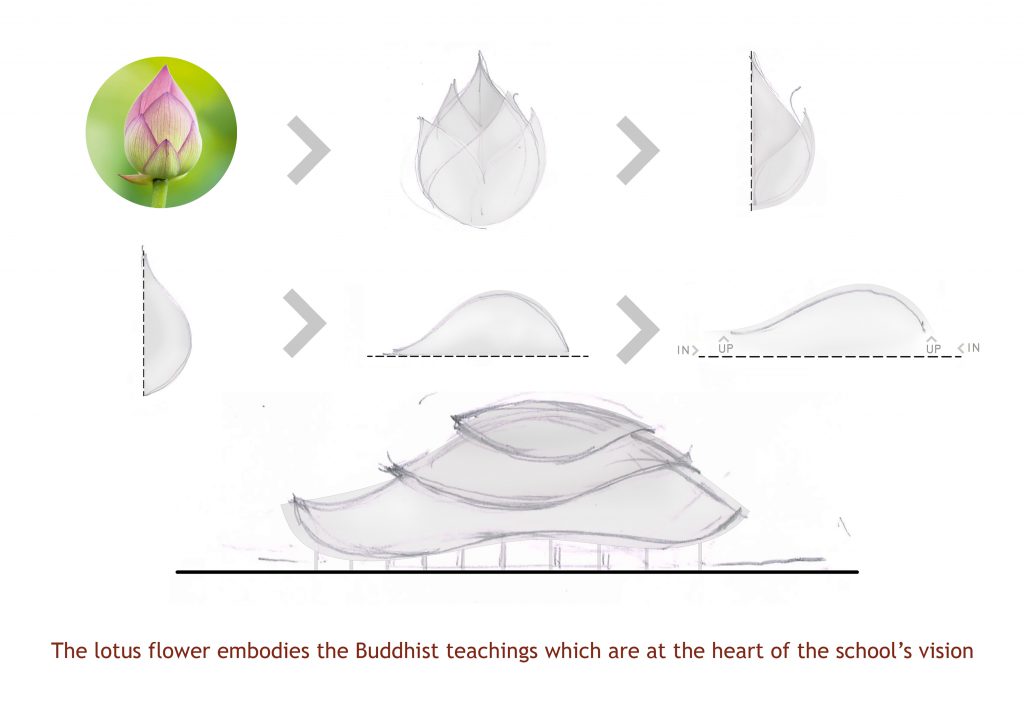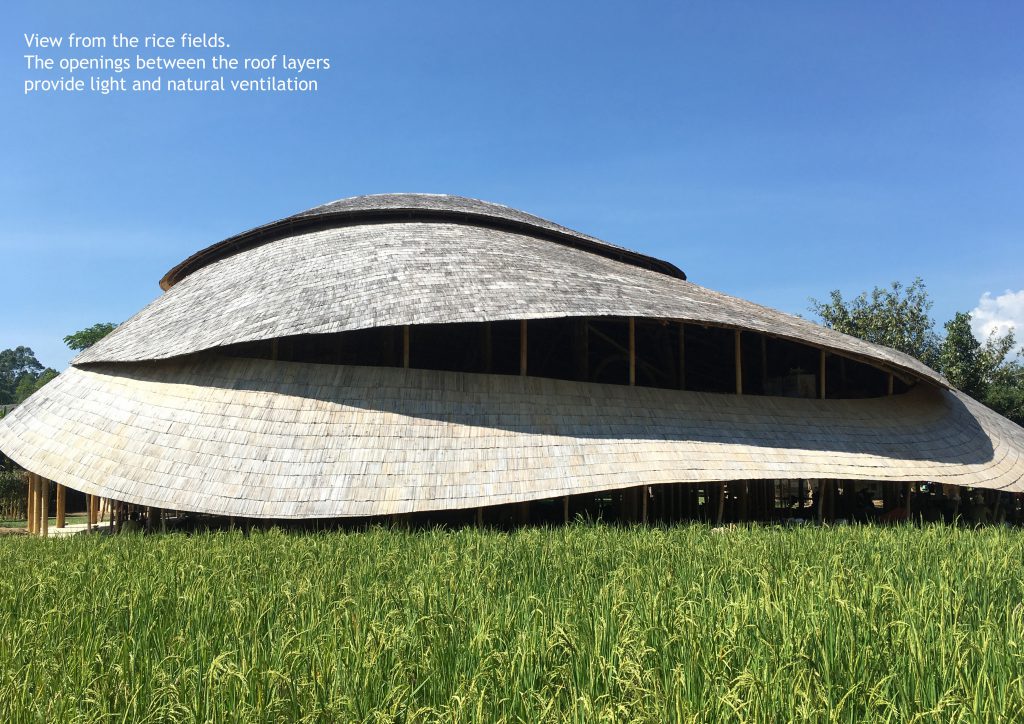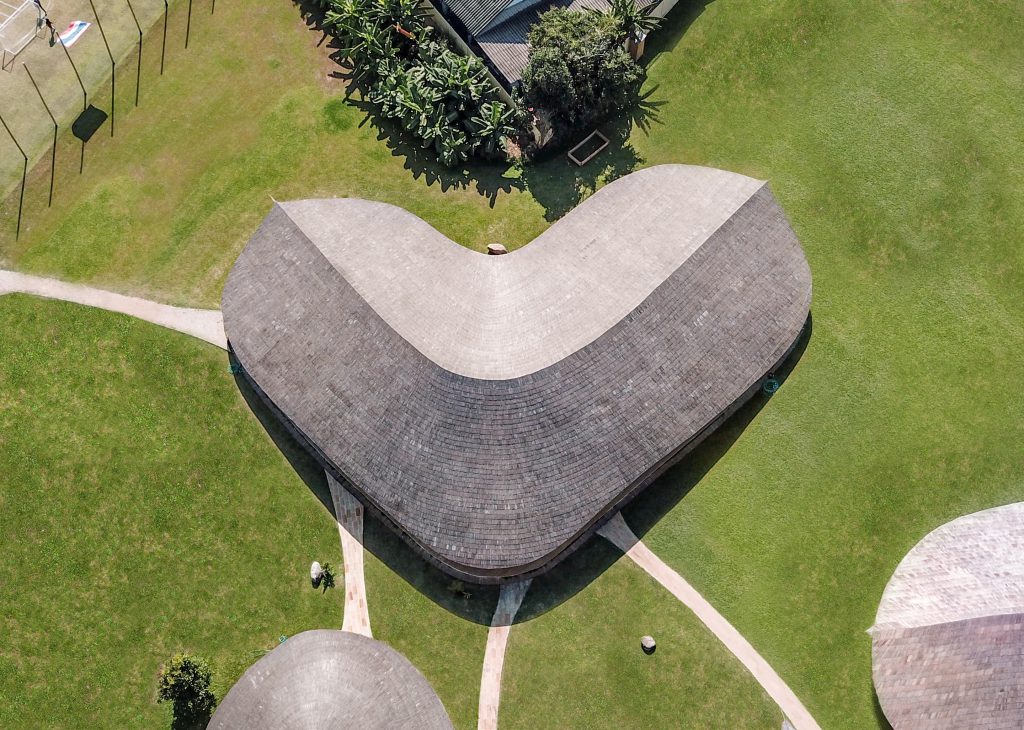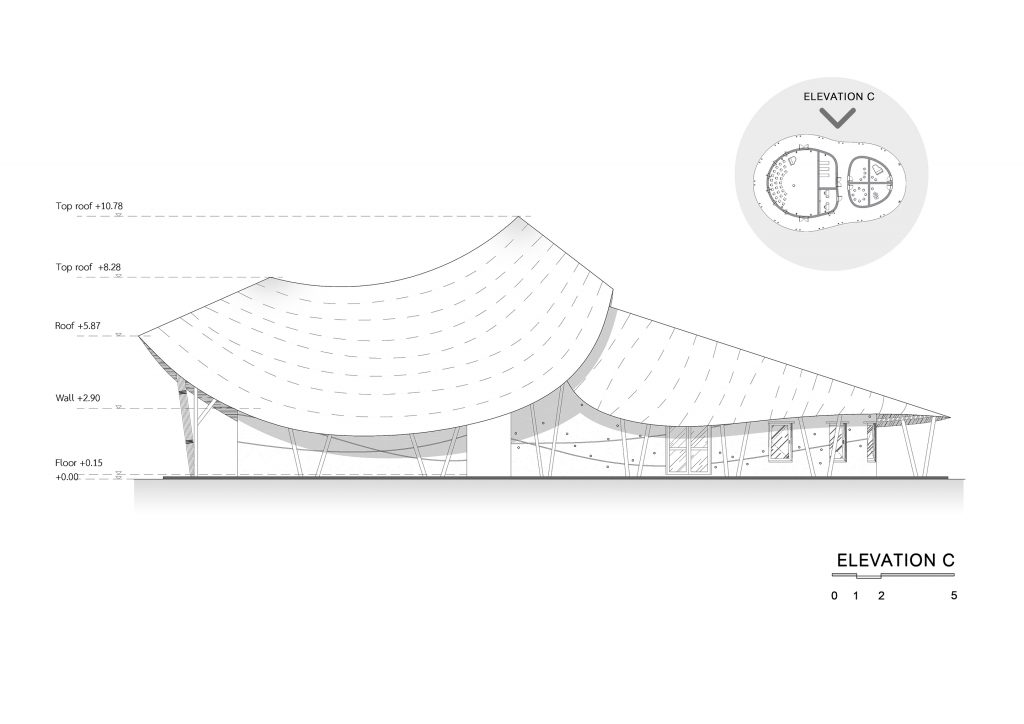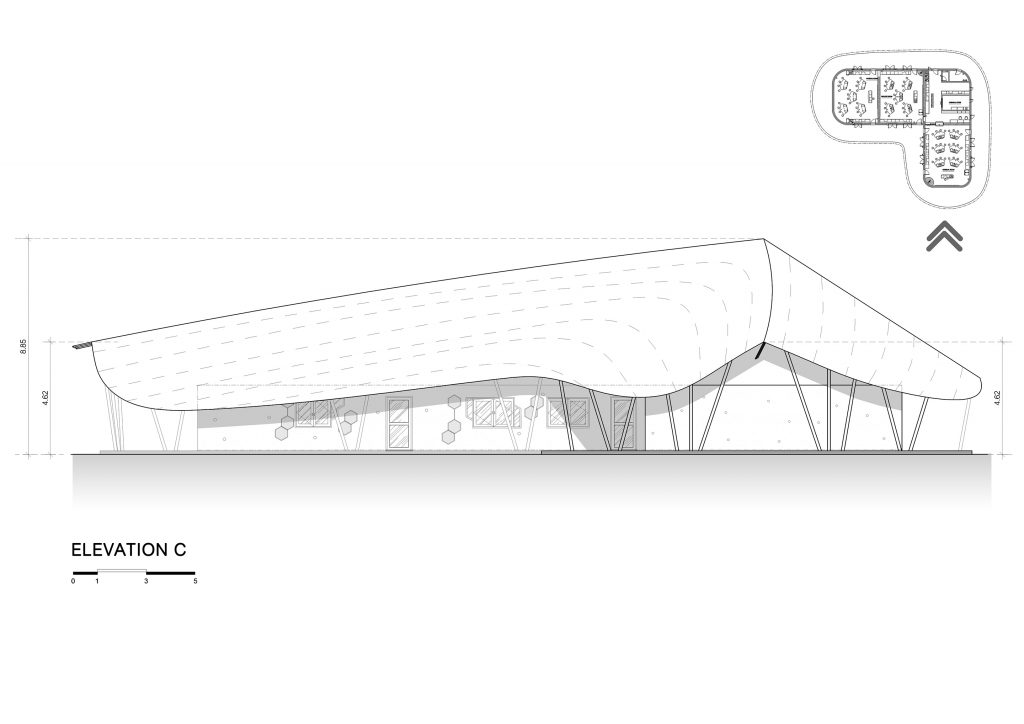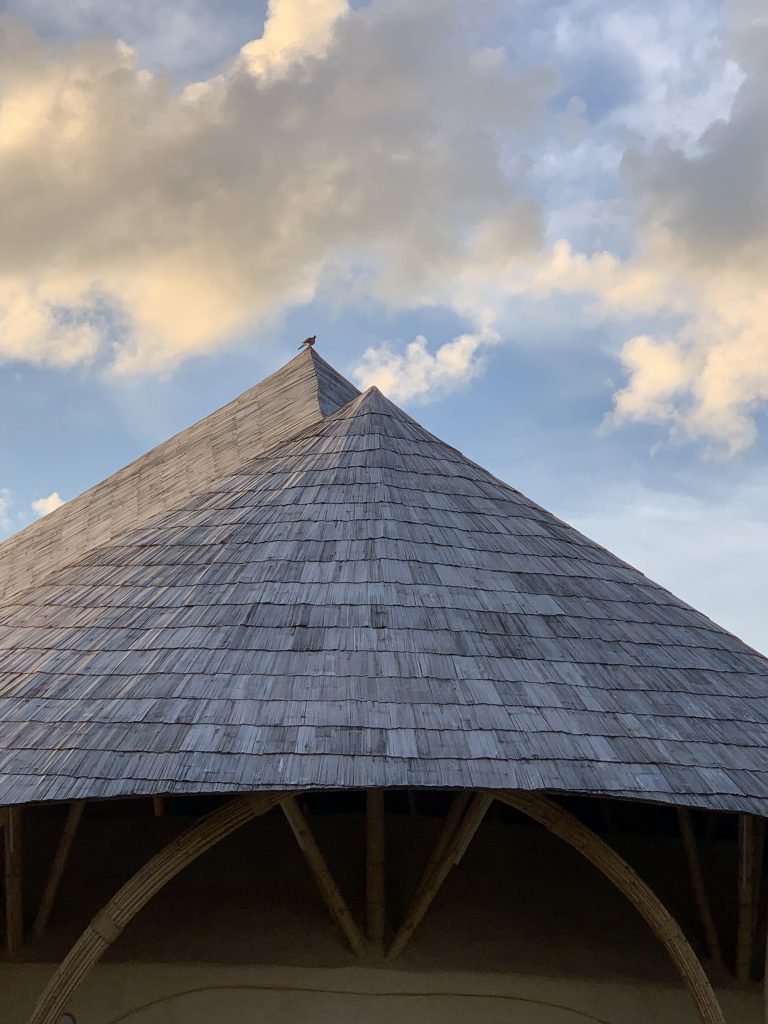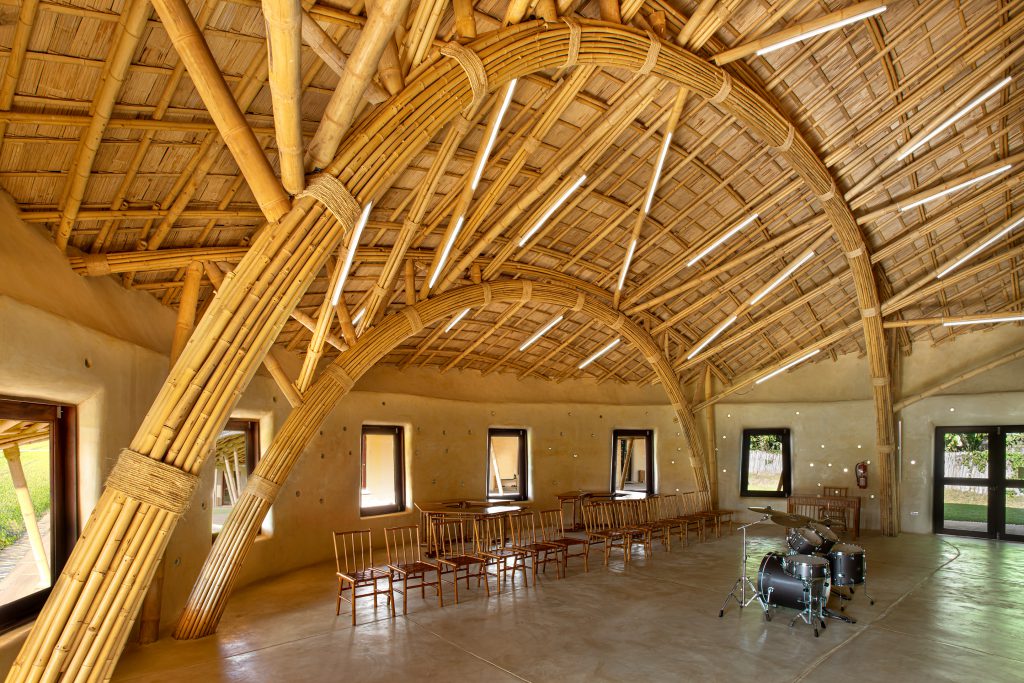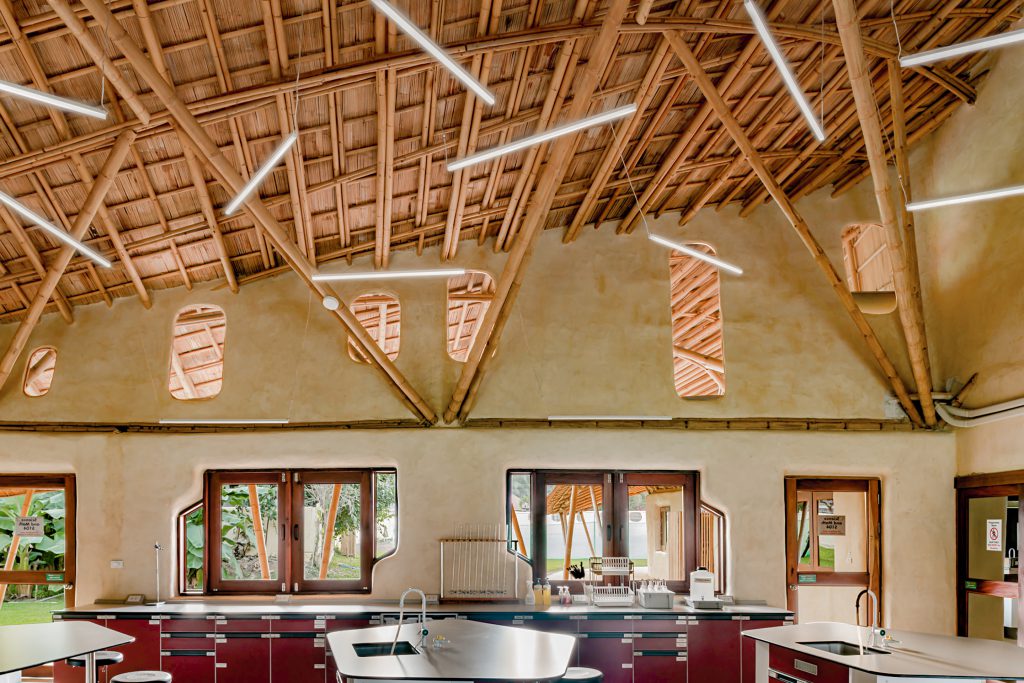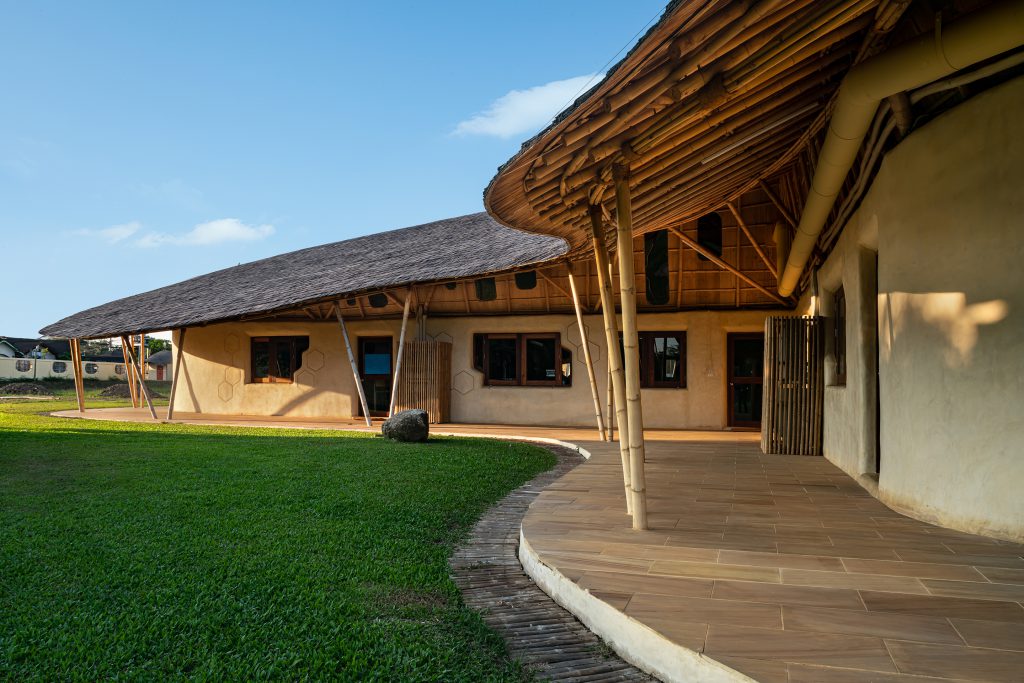Bamboo is a very viable material, not only strong but also lasting and beautiful said Markus Roselieb, the founder of Chiangmai Life Architects.
Text: Natre Wannathepsakul
Photo Courtesy of Alberto Cosi, Markus Roselieb and
Chiangmai Life Architects (CLA) except as noted
Download the online journal Issue 04 Towards Circular Living Click here

ในช่วงเวลาที่ลูกๆ กำลังโต Markus Roselieb ตัดสินใจย้ายจากกรุงเทพฯสู่เชียงใหม่ เพื่อให้เด็กๆ ได้ใช้ชีวิตใกล้ชิดกับธรรมชาติมากขึ้นเหมือนกับตอนที่เขาเติบโตมาในออสเตรีย ส่วนภรรยาของเขา ยอดเพชร สุดสวาท ต้องการที่จะก่อตั้งโรงเรียนที่จะให้การศึกษาแบบเน้นคุณค่า (value-based education) ที่เด็กๆ จะได้รับการดูแลทั้งกาย ใจ และจิตวิญญาณ ด้วยหลักการที่อ้างอิงอยู่กับหลักพระพุทธศาสนาที่ถูกควบรวมเข้าไปเป็นส่วนหนึ่งของหลักสูตรและกิจวัตรประจำวัน และในตอนนั้น Roselieb ได้รับมอบหมายให้ออกแบบอาคารเรียน หนึ่งทศวรรษให้หลังนับตั้งแต่การก่อตั้งในปี 2010 โรงเรียนนานาชาติปัญญาเด่นเป็นที่รู้จักในระดับนานาชาติ เนื่องมาจากปรัชญาการศึกษาทางเลือกรวมไปถึงโครงสร้างสถาปัตยกรรมที่ก่อร่างสร้างตัวอย่างเป็นธรรมชาติของไผ่และดิน ที่สถาปนิกชื่อดังอย่าง Frank O. Gehry ยังเคยเป็นหนึ่งในผู้มาเยือน
Roselieb ผู้มีดีกรีแพทย์และไม่มีพื้นหลังทางการศึกษาใดๆ ที่เกี่ยวข้องกับสถาปัตยกรรมเลย ได้ก่อตั้งสตูดิโอมือรางวัลในชื่อ Chiangmai Life Architects (CLA) ที่มีความเชี่ยวชาญในงานโครงสร้างไผ่และดิน โดยมีเขาและสถาปนิก ทศพล สิทธิวงศ์ ผู้เข้ามาร่วมทีมในปี 2013 เป็นผู้นำทัพโรงเรียนนานาชาติปัญญาเด่นตั้งอยู่ในอำเภอหางดง ในพื้นที่ชุมชนที่อยู่อาศัยชานเมืองด้านตะวันตกเฉียงใต้ของเชียงใหม่ โรงเรียนที่ยังอยู่ในระหว่างการก่อสร้างนี้สะท้อนปรัชญาที่ตั้งอยู่บนการเรียนรู้จากการลงมือทำ เช่นเดียวกับงานออกแบบของอาคารเรียนหลังใหม่ที่ยังคงวิวัฒนาการไปพร้อมๆ กับองค์ความรู้ด้านการใช้ไผ่ในฐานะวัสดุก่อสร้างของ Roselieb เอง
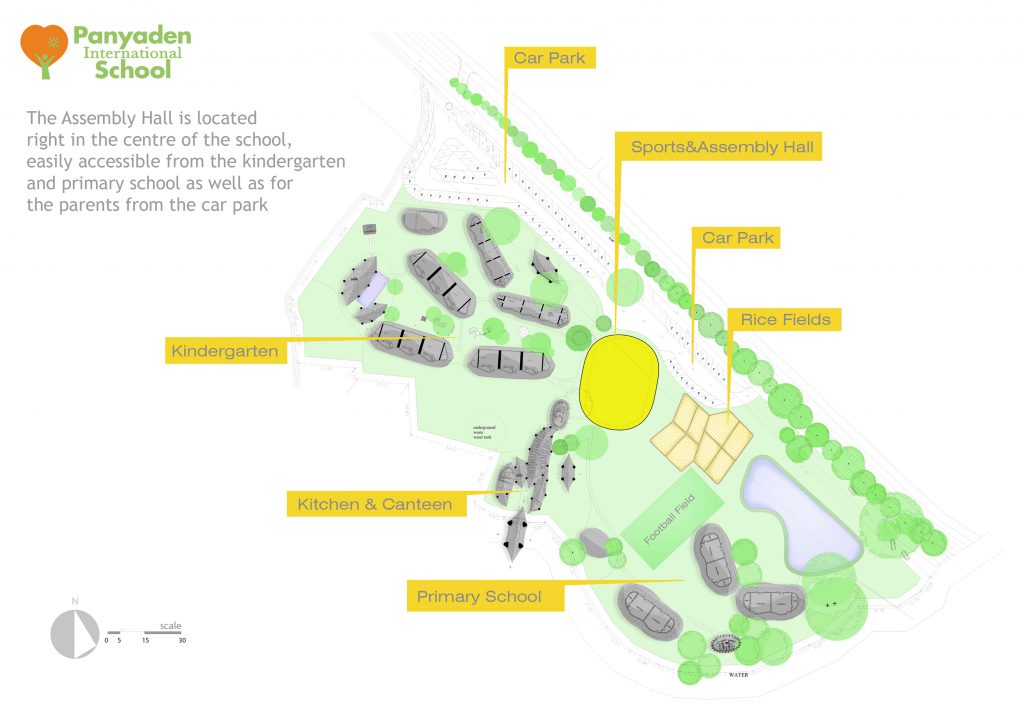
แรกเริ่มเดิมที Roselieb รู้แค่ว่าเขาต้องการจะสร้างอาคารขึ้นมาโดยใช้ไผ่และดิน ด้วยความสนใจที่ถูกจุดประกายขึ้นที่งาน World Bamboo Congress ครั้งที่ 8 ที่จัดขึ้นที่กรุงเทพฯในปี 2009 จุดมุ่งหมายคือการใช้วัสดุธรรมชาติที่จะช่วยสร้างสภาพแวดล้อมภายในที่มีความเย็นสบาย และลดการใช้เครื่องปรับอากาศ ด้วยความช่วยเหลือของสำนักงานออกแบบสัญชาติดัตช์อย่าง 24H-architecture ห้องเรียนชั้นอนุบาลถูกทำให้เป็นรูปเป็นร่างขึ้นด้วยกำแพงดินอัดที่ทำหน้าที่รับน้ำหนักโครงสร้าง ในขณะที่กำแพงโค้งนั้นถูกสร้างขึ้นจากอิฐดินดิบ หลังคาไผ่ที่โค้งขยายเป็นโครงสร้างคล้ายถ้ำวางตัวอยู่บนแนวกำแพงดินอัด ปกคลุมด้านบนของห้องเรียนที่มีกำแพงสูงไปจนแตะฐานของโครงสร้างหลังคา ห้องที่ไม่มีฝ้าส่งผลให้ช่องระหว่างหลังคาและกำแพงสร้างการไหลเวียนของอากาศตามธรรมชาติ และถูกเสริมด้วยช่องเปิดที่มีลักษณะแคบยาวบนหลังคา ห้องเรียนจึงมีความเย็นและระบายอากาศได้โดยธรรมชาติ พื้นที่การใช้งานอื่นๆ เช่น ครัวและห้องอาหารตั้งอยู่ในภายในศาลาไผ่ที่เปิดโล่งรับอากาศธรรมชาติ
อย่างไรก็ดี ไฟป่าและหมอกควันที่เกิดขึ้นทุกช่วงต้นปีได้กลายเป็นปรากฏการณ์ที่เกิดขึ้นทุกปีไปแล้วในปัจจุบัน ปรากฏการณ์ดังกล่าวส่งผลต่อจังหวัดในภาคเหนือของไทยโดยตรง รวมไปถึงระดับมลพิษทางอากาศในเชียงใหม่ที่เลวร้ายยิ่งกว่าในเมืองหลวงของประเทศ การให้เด็กๆ ต้องเจอกับสภาพแวดล้อมแบบนั้นเป็นสิ่งที่ผู้ออกแบบไม่มีวันยอมให้เกิดขึ้น แม้ว่าการใช้วิธีการเชิง passive และการใช้วัสดุธรรมชาติจะเป็นทางเลือกแรกในการออกแบบ แต่ Roselieb ก็มีความชื่นชอบในการผสมผสานวิถีธรรมชาติเข้ากับเทคโนโลยีสมัยใหม่ และสิ่งหนึ่งที่เขาภูมิใจนำเสนอ คือ ระบบกรองและปรับอากาศที่ถูกติดตั้งเพิ่มในห้องเรียนทั้งหมด ที่ตอนนี้จะถูกปิดด้วยฝ้าไผ่ ระบบนี้ช่วยสร้างห้องความดันบวกจากการปั๊มเอาอากาศสะอาดที่ผ่านการกรองแล้วเข้าสู่ห้องเรียน ในขณะเดียวกันก็ช่วยทำให้อุณหภูมิภายในห้องเรียนลดต่ำลงอยู่ในระดับน่าสบาย
ในขณะที่ฤดูกาลไฟป่าหมายถึงการออกแบบอาคารใหม่ให้มีรูปแบบพื้นที่ที่มีลักษณะปิดอย่างสิ้นเชิงและการใช้ระบบปรับอากาศ ความเปลี่ยนแปลงที่เห็นได้ชัดที่สุดจะเป็นในส่วนของโครงสร้างอาคาร เดิมทีอาคารสร้างขึ้นจากโครงสร้างสามเหลี่ยมที่ข้อจำกัดคือช่องเปิดที่เตี้ยและแคบ ในเวลาเดียวกัน ท่อนไผ่ขนาดใหญ่ที่ถูกนำมาใช้นั้นก็ดูจะมีขนาดที่ไม่สมส่วนกับพื้นที่ขนาดเล็กที่เกิดขึ้น ด้วยความช่วยเหลือจากวิศวกร Phuong Nguyen และ Esteban Morales Montoya สำนักงาน CLA ได้บุกเบิกการใช้ระบบโครงถักไผ่ที่ทำขึ้นที่โรงงาน ก่อนจะถูกนำมาใช้กับการก่อสร้างโถงกีฬาของโรงเรียนที่มีรูปลักษณ์โดดเด่น โดยการก่อสร้างนั้นแล้วเสร็จไปในปี 2017 “นั่นคือจุดที่ผมเริ่มรู้สึกสนุก” Roselieb บอกกับเรา “มันช่วยเบิกทางเราขึ้นไปสู่อีกขั้นหนึ่งของไผ่” มันยังเป็นช่วงเวลาที่รางวัลเริ่มหลั่งไหลเข้ามาหาทีมออกแบบแห่ง CLA
โถงกีฬาคลุมสนามบาสเก็ตบอลเอาไว้ด้วยโครงสร้างไผ่ถักที่มีระยะพาดกว่า 17 เมตร ทีมออกแบบใช้ไผ่กว่าหกสายพันธุ์สำหรับการสร้างโครงสร้างนี้ แต่ละส่วนของโครงถักประกอบไปด้วยแท่งไผ่บางยาวที่ถูกถักรัดเข้าด้วยกันด้วยเส้นเหล็กที่ภายนอกถูกหุ้มด้วยเชือกอีกหนึ่งชั้น สร้างรูปลักษณ์ให้กับโครงสร้างที่ดูใหญ่โตแต่ก็ดูบอบบางในคราวเดียวกัน “ผมชอบไผ่ที่มีขนาดเล็กมากกว่า เพราะหากพูดถึงในแง่มุมของสถาปัตยกรรมและงานออกแบบแล้ว เส้นสายต่างๆ จะมีความละเอียดอ่อนกว่า” Roselieb บอก ด้วยจุดสูงสุดของอาคารอยู่ที่ 10 เมตร โถงนี้จึงเป็นพื้นที่ขนาดใหญ่ที่น่าตื่นตาตื่นใจ ที่แม้จะมีการใช้ไผ่ท่อนใหญ่อยู่บ้างก็ไม่ได้ทำให้รู้สึกผิดที่ผิดทางแต่อย่างใด การใช้ไผ่แท่งเล็ก ๆ ยังมีจุดประสงค์ด้านการใช้งานซ่อนอยู่อีกด้วย “ถ้าดูที่เคเบิ้ลเหล็ก จะเห็นว่าทำจากเส้นโลหะจำนวนมาก ทำให้แข็งแรงกว่าการใช้เส้นโลหะขนาดใหญ่เส้นเดียว เพราะว่าความยืดหยุ่นที่มากกว่า หลักการนั้นก็คล้ายกับสิ่งที่เราทำกับไผ่ที่นี่ เพราะเวลาเรามัดมันเข้าด้วยกันแบบนี้ ก็กลายเป็นเหมือนเคเบิ้ลเหล็กที่มีความแข็งแรงและแทบจะเป็นไปไม่ได้เลยที่มันจะขาดออกจากกันเพราะความคงทนต่อแรงดึงสูงมาก”
ส่วนของหลังคาได้รับแรงบันดาลใจมาจากรูปทรงของดอกบัว ประกอบไปด้วยชั้นของหลังคาสามชั้นที่มีช่องเปิดขนาดใหญ่ที่เกิดจากการทับซ้อนกันของมวลแผ่นหลังคา ช่วยนำแสงและการระบายอากาศธรรมชาติเข้ามาสู่พื้นที่ใช้สอย “เราได้ให้วิศวกรจำลองการไหลของลม ในขณะที่น้ำหนักของวัสดุก็ไม่ได้เป็นปัญหาอะไรเลยเพราะตัวหลังคามีความเบามาก” Roselieb อธิบาย “ไผ่มีความแข็งแรง แรงกดที่เกิดขึ้นจึงมาจากลมและแรงเฉือนมากกว่า แผ่นดินไหวก็ไม่ใช่ปัญหาใหญ่อะไรสำหรับอาคารด้วยเช่นกัน ถ้าหากในอนาคตมีแผ่นดินไหวเกิดขึ้นในเชียงใหม่ อาคารของเราจะเป็นสิ่งก่อสร้างสุดท้ายที่ยังตั้งอยู่ ไผ่ทนทานต่อแผ่นดินไหวเพราะมันสามารถเคลื่อนตัวได้โดยที่ไม่เกิดความเสียหายใดๆ เพราะไผ่ก็เคลื่อนตัวไปมาของมันอยู่แล้ว” ยิ่งไปกว่านั้น ด้วยรูปร่างที่มีความโค้ง ลมที่พัดมาจึงอ้อมตัวโครงสร้างและส่งผลให้ฝนไม่เข้ามาในพื้นที่ภายในแม้ในส่วนของช่องเปิดที่มีความสูงถึงสองเมตรในบางส่วนของอาคาร

ในปี 2018 การก่อสร้างส่วนต่อเติมที่จะเป็นโรงเรียนมัธยมเริ่มขึ้นเนื่องมาจากจำนวนนักเรียนที่เพิ่มมากขึ้น ในปัจจุบัน ส่วนต่อขยายบางส่วนรวมไปถึงห้องทดลองทางวิทยาศาสตร์ ศูนย์ดนตรี โดยมีอาคารห้องเรียนชั้นมัธยมความสูงสองชั้นตั้งอยู่ตรงกลาง ส่วนอาคารวิชาเฉพาะที่แต่ละหลังมีรายละเอียดทางการออกแบบอันเป็นเอกลักษณ์ วางตัวอยู่โดยรอบ กลุ่มอาคารใหม่เหล่านี้ถูกปกคลุมด้วยโครงสร้างหลังคาสองชั้น และมีพื้นที่ใช้งานขนาดใหญ่ สูง และสว่างกว่าที่ผ่านมา อันเป็นผลมาจากประสบการณ์ของการทดลองและความผิดพลาดในอดีตจากการสร้างอาคารก่อนหน้า รวมไปถึงความรู้ด้านโครงสร้างที่เพิ่มมากขึ้น โครงสร้าง V ถัก ที่ผลิตขึ้นที่โรงงานนั้นมีน้ำหนักเบา ใช้ไผ่จำนวนน้อยลง หากแต่มีความแข็งแรงกว่าเดิม โดยมีการใช้เดือยไผ่แทนนอตและตะปู อาคารศูนย์ดนตรีนั้นพิเศษตรงการแสดงออกถึงภาษาทางสถาปัตยกรรมใหม่ของโรงเรียนในระยะที่สอง จากตัวโครงสร้างก่อให้เกิดพื้นที่ภายในที่ปราศจากเสา ในขณะที่ช่องรับแสงที่ด้านบนของผนังให้ความรู้สึกเป็นอันหนึ่งอันเดียวกับรูปทรงของหลังคา ศูนย์ดนตรีถูกแยกออกเป็นสองส่วนเพื่อสร้างประสิทธิภาพในการกันเสียงที่ดีกว่า และเพื่อรองรับการใช้งานหลักของอาคารเป็นพื้นที่จัดการแสดงขนาดใหญ่และห้องซ้อมแยกขนาดเล็กอีกจำนวนหนึ่ง ศูนย์ดนตรีนี้เชื่อมอยู่กับห้องอาจารย์และห้องเก็บเครื่องดนตรี ส่วนห้องทดลองทางวิทยาศาสตร์ประกอบไปด้วยห้องสี่ห้องที่มีขนาดเกือบเท่ากันทั้งหมด แยกเป็นห้องชีววิทยา เคมี ฟิสิกส์ และห้องเตรียมการ ทั้งสี่ห้องถูกจัดวางให้อยู่ในผังรูปทรงหัวใจเมื่อมองจากด้านบน ในส่วนของห้องเรียนนั้น อาคารสามอาคารวางเรียงตัวล้อมรอบลานตรงกลาง โดยห้องเรียนได้รับการออกแบบให้หันหน้าเข้าหาลานเพื่อไม่ให้พื้นที่ภายในถูกรบกวนจากภายนอก แต่ในขณะเดียวกัน แต่ละอาคารก็ถูกเชื่อมโยงเข้าด้วยกันโดยสะพานที่ช่วยส่งเสริมปฏิสัมพันธ์ระหว่างนักเรียน ภายในของแต่ละห้องนั้นถูกออกแบบให้มีเพดานสูงและมีกำแพงที่สร้างขึ้นจากการสานและโปะดิน
Roselieb บอกว่า CLA “ไม่ใช่กลุ่มนักออกแบบที่คำนึงถึงแต่เพียงการออกแบบสีเขียวเท่านั้น” แต่แน่นอนว่าพวกเขามีความใส่ใจและให้ความสำคัญกับสิ่งแวดล้อมเป็นอย่างมาก ไผ่ที่พวกเขาใช้นั้นได้มาจากป่าชุมชนที่อยู่ในรัศมี 100 กิโลเมตรของโรงเรียน ส่วนไม้เนื้อแข็งที่ใช้กับกรอบประตูและหน้าต่างนั้นเป็นวัสดุเก่าที่ถูกนำมาใช้ใหม่ ในขณะที่อาคารกีฬาใช้ลูกบอลยางใช้แล้วมาเป็นวัสดุรองปูพื้น Roselieb ยังเสริมว่าไผ่นั้น “เป็นวัสดุชนิดเดียวที่มีค่าคาร์บอนเป็นลบตั้งแต่แรกเริ่ม เพราะมันทำหน้านี่ดูดซึมคาร์บอนตั้งแต่ระหว่างกระบวนการผลิต ในขณะที่คอนกรีตและเหล็กนั้นผลิตคาร์บอนด้วยกันทั้งสิ้น” ในแง่มุมของการใช้งาน ไผ่และดินยังเป็นฉนวนที่ป้องกันความร้อนและเสียงได้ดีกว่าคอนกรีตและเหล็กอีกด้วย
ความสนใจที่ Roselieb มีต่อวัสดุธรรมชาติเหล่านี้ถูกส่งต่อไปยังผู้อื่นด้วยเช่นกัน ปัญหาหลักก็คือ การรับรู้ของคนไทยที่ยังมองว่าไผ่เป็นวัสดุของคนจน ที่ไม่มีความแข็งแรงทนทานมากพอสำหรับงานก่อสร้าง ความเชื่ออย่างหลังนั้นเกิดจากความไม่รู้ เขาอธิบายว่าการขาดความรู้ความเข้าใจอย่างแท้จริงนั้นเป็นสิ่งที่ทำให้เกิดมุมมองเหล่านี้ เมื่อไผ่มีอายุและโตมากพอ หรือราวๆ สี่ปี องค์ประกอบน้ำตาลจะลดลงและส่วนที่เป็นใยจะเพิ่มขึ้นมากจนพอที่จะสามารถทำให้ไผ่มีศักยภาพเป็นวัสดุก่อสร้างได้ และเมื่อไผ่ได้รับการเตรียมและปรับสภาพอย่างเหมาะสม “ไม่มีเหตุผลอะไรที่จะไม่เชื่อว่าไผ่สามารถมีอายุการใช้งานยืนยาวได้ถึง 50-80 ปี หรือแม้กระทั่ง 100 ปี” เขาอธิบาย “ก็เหมือนไม้ ไผ่มีอายุการใช้งานที่ยืนยาวพอๆ กันได้ถ้าไม่มีองค์ประกอบอื่นๆ มาส่งผลกระทบ ไผ่เป็นทางเลือกที่เหมาะสมเพราะไม่ได้แค่แข็งแรงอย่างเดียว แต่ยังมีอายุยาวนาน แล้วก็สวยอีกด้วย คุณไม่ต้องทาสีทับ เพราะมันดูดีโดยธรรมชาติอยู่แล้ว ความยากก็คือมุมมองที่ว่าวัสดุเหล่านี้ไม่แข็งแรงมากพอ ทั้งที่ความเป็นจริงแล้วมันไม่ใช่แบบนั้นเลย สิ่งที่เราต้องทำก็คือให้ความรู้ แล้วก็สร้างงานเพิ่มขึ้นเรื่อยๆ แล้วความตระหนัก ยอมรับในคุณสมบัติด้านการใช้งานและความคงทนของมันก็จะค่อยๆ เพิ่มขึ้น ปัญหาที่สองเป็นเรื่องของกฎหมายข้อบังคับ ซึ่งก็เหมือนกัน คือเกิดขึ้นจากการไม่มีความรู้เพียงพอและการมีอคติไปแล้วล่วงหน้า” ปัญหาที่เกี่ยวกับกฎหมายนั้นหมายความถึงการสร้างอาคารสองชั้นจะต้องมีโครงคอนกรีตเพื่อให้แบบผ่านการอนุมัติโดยเจ้าหน้าที่ท้องถิ่น แม้ในความเป็นจริงแล้วมันไม่มีความจำเป็นใดๆ ที่อาคารนั้นจะต้องมีโครงสร้างคอนกรีตที่ว่าเลย Roselieb จัดการปัญหานี้ด้วยการมองมันตามสถานการณ์จริง เขาเพิ่มเสาคอนกรีตเท่าที่จำเป็นเพื่อให้แบบผ่านการอนุมัติแล้วก็คลุมมันด้วยไผ่อีกที ด้วยจุดมุ่งหมายคือการได้สร้างงานจริงต่อไปเรื่อยๆ
เวลาที่ Markus Roselieb พูดถึงไผ่นั้น เขามักจะพูดถึงเรื่องคุณสมบัติของวัสดุ เทคนิคเชิงวิศวกรรมและการก่อสร้าง และการทดลองที่ยังคงดำเนินไปอย่างต่อเนื่อง “ในแง่มุมปรัชญา เราแตกต่างจากบริษัทไผ่อื่นๆ เราไม่ใช่ฮิปปี้ แล้วเราก็ไม่ใช่นักออกแบบแนวประเพณีนิยม เพราะไผ่ไม่ใช่วัสดุเชิงประเพณีนิยมที่นี่ เราต้องบอกก่อนว่าสถาปัตยกรรมประเพณีนิยมในไทยนั้นคือสถาปัตยกรรมไม้ ไม่ใช่ไผ่ เพราะไม่มีองค์ความรู้ด้านนี้มาก่อน เราทำงานเพื่อสร้างสิ่งที่นำไปใช้ได้จริง เราอยากจะนำเสนอวัสดุนี้ในบริบทของศตวรรษที่ 21 เราอยากจะให้มันกลายเป็นวัสดุก่อสร้างที่ได้รับการยอมรับอย่างกว้างขวาง แนวทางของผมจะเน้นไปที่แง่มุมด้านวิศวกรรม ความแข็งแรงเชิงการใช้งาน เพราะนั่นเป็นสิ่งที่คนทั่วไปเข้าใจและเข้าถึง ผมคิดว่าสิ่งที่เราจะทำต่อไปก็คือการสร้างโครงถักสามมิติ และถึงจุดหนึ่งมันจะทำหน้าที่เป็น Space Frame สำหรับโครงสร้างช่วงพาดกว้าง นั่นคือความฝันของผมเลย การสร้างหลังคาโครง Space Frame ที่จะสามารถทอดตัวคลุมพื้นที่ระยะยาว 40-50 เมตร เราลองสร้างโครงสร้างแบบที่ว่าในขนาดเล็กมาแล้ว แต่ตอนนี้มันเป็นงานที่ต้องใช้แรงงานเยอะมากและในแง่ของมูลค่าการก่อสร้างก็ยังเป็นสิ่งที่เป็นไปได้ยากอยู่”
แม้พื้นที่ส่วนห้องเรียนอนุบาล ประถม และมัธยมของโรงเรียนจะอยู่ในพื้นที่โครงการเดียวกัน ส่วนมัธยมจะเป็นส่วนที่มีทางเข้าแยก โดยใช้ถนนที่ขนาบข้างขอบที่ดินฝั่งจะวันตกของโรงเรียน ทางเข้าของส่วนมัธยมนั้นถูกสร้างขึ้นในรูปของอุโมงค์โค้งที่ค่อยๆ ยกตัวและพับขึ้นเป็นรูปทรงที่ชวนให้นึกถึงปีกของนกเวลาสยายออกบิน โครงสร้างที่มีความเป็นประติมากรรมนี้เป็นการแสดงความเคารพต่อสถาปนิกคนโปรดของ Roselieb และ Santiago Calatrava ก็คือสถาปนิกคนที่ว่า

When his children were growing up, Markus Roselieb decided to relocate his family to Chiang Mai from Bangkok in order for them to be closer to nature, as he was when growing up in Austria. His wife, Yodphet Sudsawad, wanted to start a school that would offer a value-based education, where children are nurtured physically, mentally and spiritually, where principles drawn from Buddhism are part of the curriculum and everyday routines. Roselieb was tasked with the school buildings and now, just over a decade later after its foundation in 2010, Panyaden International School is known internationally not only for its alternative educational philosophy but also for its agglomeration of organically-shaped structures in bamboo and earth that count Frank O. Gehry among its many visitors.
While Roselieb, who has a medical degree and no educational background in architecture, founded an internationally award-winning practice Chiangmai Life Architects (CLA), specialising in bamboo and earth structures and which is now led by himself and architect Tosapon Sittiwong, who joined in 2013.
Located in the Hang Dong district of Chiang Mai, in the suburban area southwest of the city center, the campus is a work-in-progress that reflects the school’s mantra of learning by doing, as the design of the new school buildings continues to evolve along with Roselieb’s knowledge of bamboo as a construction material. Initially, he knew only that he wanted to build with bamboo and earth, an interest that was sparked off by the 8th World Bamboo Congress, which was held in Bangkok in 2009. The aim was to use natural materials that would create cool and comfortable interior environments and reduce the use of air conditioning. With the help of Dutch practice 24H-architecture, the kindergarten classrooms were realised with straight load-bearing rammed-earth walls, while the curved walls were constructed from adobe bricks. The cavernous bamboo roof structures rest on these rows of 3 or 4 rammed-earth walls, hovering above the classrooms, whose walls rise just to the height of the base of the roof. The rooms have no ceilings so the gap between the roof overhang and the walls allow for natural airflow, aided further by slit-like openings on the roof itself. The rooms were cool and naturally ventilated. Facilities such as the kitchen and canteen are housed in open-air bamboo pavilions.
However, with the onset of the ‘burning season’ that now occurs annually in the early months of the year and affects the northern region of Thailand, the air pollution level in Chiang Mai is worse than even in the capital, and subjecting children to such conditions is of course out of the question. While the use of passive methods and natural materials are preferred, Roselieb is in fact enthusiastic to combine the natural and traditional with the latest technologies. He proudly presented the dual air filtering and conditioning system that has been installed in all of the existing classrooms, now covered up with bamboo ceilings. The system creates positive pressure rooms by continually pumping filtered fresh air into the room as well as cooling it.
While the burning season means that any new building design will have to be based on fully-enclosed mechanically-ventilated rooms, the most significant changes have been affected in the structural design itself. The initial buildings made use of triangular structure, whose limitation was low openings; at the same time, large bamboo elements were used and they seemed out of scale with the small spaces they engendered. With the help of engineers Phuong Nguyen and Esteban Morales Montoya, CLA pioneered a system of prefabricated bamboo trusses that was utilised most strikingly for the school’s sports hall, completed in 2017. “That’s when it started to be fun,” says Roselieb, “it really pioneered a different phase for bamboo.” It was also when the accolades started pouring in.

The sports hall covers a basketball court, with bamboo trusses spanning up to 17 meters and as many as six different species of bamboo were used for the whole structure. Each truss is composed of many slender bamboo poles tied together with metal bands that are then covered up with rope, creating the appearance of a huge but dainty structure. “I prefer smaller because in terms of architecture and design the lines become more subtle,” says Roselieb. Ten meters high at its highest point, the hall is a majestic space, even the larger poles do not feel out of place here. There is also a more practical purpose: “if you look at steel cables, they’re made out of lots of different steel fibers and it’s much stronger than if you’d have one cable because of the additional elasticity. So the same applies here because we make bundles like this, they’re like steel cables, almost impossible to tear apart. The tensile strength becomes so high.”
The roof, inspired by the lotus flower, is composed of three layers that allow for large openings where they overlap to let in natural light and ventilation. “The engineers did wind channel simulations for this building. Material load is never a problem because the roofs are so light,” explains Roselieb, “and the bamboo is strong, so the loads are basically wind load and sheer force. Earthquakes are also never a problem, if we ever have an earthquake in Chiang Mai, these will be the last buildings standing. The bamboo just lasts with earthquakes because it can move and nothing happens because it’s used to moving.” Also because of the curved shape, the wind goes around it, so that the rain doesn’t penetrate to the interior even where the openings are as high as two meters in some parts.
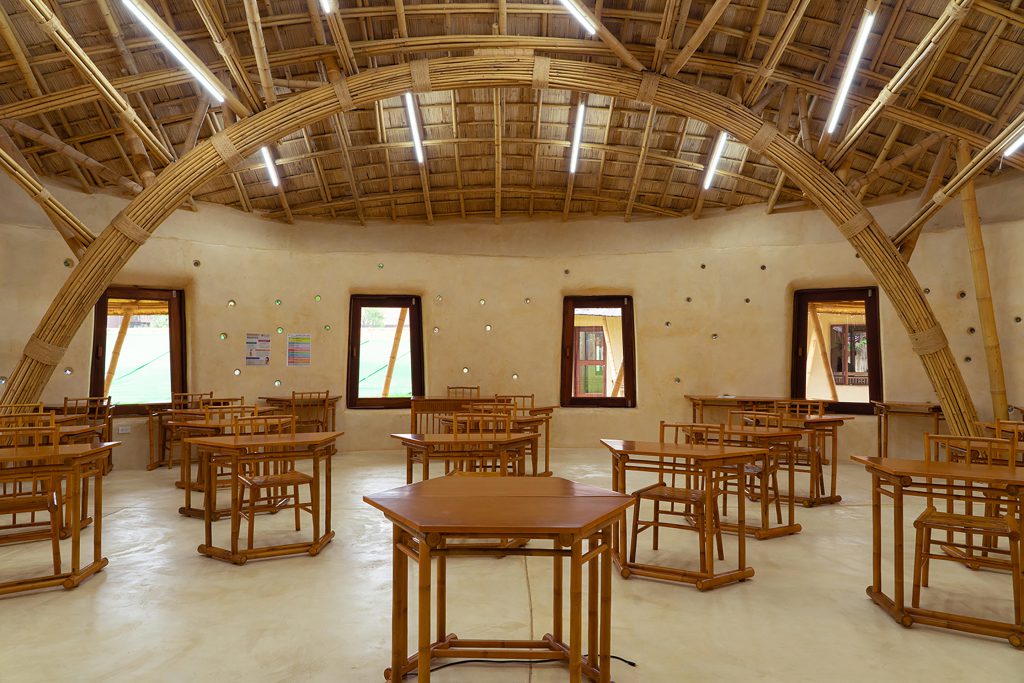
In 2018, the construction of the secondary school addition began as the student body grows up and expands. Currently, some of the new addition includes the science labs, music e, and the two-storey secondary school classrooms. The latter is placed in the center and the specialised buildings, each with a unique design, are placed in a circle around it. These new buildings are all closed with a double roof, the spaces are generally larger, taller and also brighter, benefitting from the knowledge gained from the trials and errors of the earlier buildings as well as the advancement in structural knowledge. The new prefabricated V trusses are lightweight, use less bamboo yet are stronger and bamboo dowels are replacing screws and nails. The music hall, in particular, showcases the new architectural language of this second phase, the structure allows for a large column-free interior space, while the clerestory windows feel integral with the design of the roof form. The music center is separated into two volumes to provide better sound insulation and also because there were two main functions: one being the large performance space of the music hall and the other being small individual rehearsal rooms. The music hall is combined with the teachers’ room and storage room for musical instruments. The science labs are composed of four rooms, almost equal in size – one for biology, chemistry, physics, and a preparation room – arranged to form a heart shape when seen from above. For the classrooms, three separate building volumes are arranged around a central courtyard, with the classrooms designed to face inward to have less distraction from outside, but also connected by bridges to foster interaction between the students. The rooms have high ceilings and wattle and daub walls.
While Roselieb says that CLA “is not the green guys as the first thing”, they are certainly mindful of the environment, the bamboo is sourced from community forests within a 100-kilometer radius, the hardwood for door and window frames are reclaimed and the sports hall uses recycled rubber balls underneath the flooring. Roselieb also adds that bamboo “is the only material that is carbon negative to start with, because it absorbs carbon during production, concrete and steel all emit carbon.” Functionally, bamboo and earth are also better insulators against heat and sound than concrete and steel.
The enthusiasm Roselieb has for these natural materials is infectious. The main problem with them though, he contends, is still that of Thai people’s perception towards bamboo as a poor man’s material and one that is neither strong nor durable. The latter beliefs are born of ignorance, he explains that it is the lack of knowledge that drives these perceptions. When bamboo is mature enough at around four years old, the sugar content goes down and fibre content goes up enough for it to be considered a construction material, then once it is properly treated, “there’s no reason to not believe why it shouldn’t last 50, 80 or 100 years.” He explains: “it’s just like wood, it can last just as long if it’s not exposed to the elements. It is a very viable option, it’s not only strong but it’s lasting and beautiful. You don’t need to paint it, it’s nice just the way it is. The difficulty is the perception that these materials are not strong, while they actually are. So, what we have to do is to educate, build and build and build and then the consciousness about the viability will rise. The second problem is the regulation problem. Same here, too little knowledge, too many preconceptions.” The ‘regulation problem’ has meant that the new two-storey building needed a concrete skeleton structure for it to be signed off by the local district officer, despite no structural necessity. Roselieb is practical about it, he delivers the concrete, which is then covered up with bamboo. The goal is always to build.
When Markus Roselieb talks about bamboo, it is about material properties, engineering and construction techniques and ongoing experimentation: “in terms of philosophy, we’re different from other bamboo companies because we are not the hippies. We are also not traditional, because bamboo is not traditional here, we have to be honest, the traditional in Thailand is wooden architecture, not bamboo, because there was no knowledge. We’re really functional, we want to bring these materials into the 21st century, we want to make them available as construction materials to the mass. My approach is focused on engineering, focused on functional strength because that’s what people can relate to. I think the next thing will be 3-dimensional trusses and at one point it will be a spaceframe. That’s my dream, to make a spaceframe roof that can cover 40-50 meters. We tried a small space frame structure, but at this point, it’s very labor-intensive and not financially viable.”
Even though the kindergarten, primary and secondary areas of the school are on the same site, there is a separate entrance for the secondary school, using a different road that borders the western perimeter of the site. The gateway into the secondary school begins as an arched tunnel that then lifts and folds up into the form reminiscent of bird wings in flight. The sculptural structure is an homage to Roselieb’s favourite architect, no prizes for guessing it’s Santiago Calatrava.



